Jan van Ees (1896-1966) was a popular Dutch actor and author of several stage plays. He was one of the title characters of the film classic De Jantjes/The Tars (1934) and starred in four more Dutch films of the 1930s.
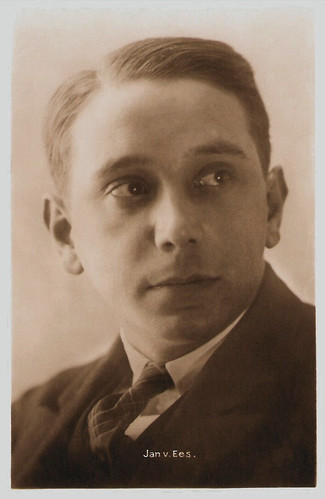
Dutch postcard by Uitgave Weenenk & Snel, Den Haag. Photo: Willem Coret.

Dutch postcard by Hollandia Film Prod. / Loet C. Barnstijn. Photo: publicity still for De Jantjes/The Tars (Jaap Speyer, 1934) with Jan van Ees, Willy Costello and Johan Kaart.
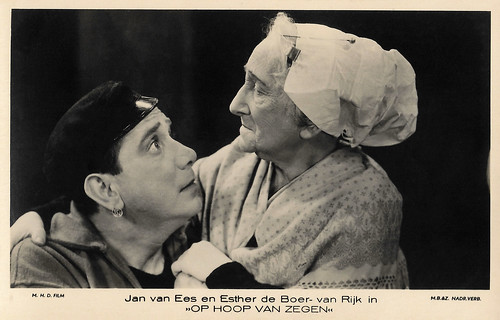
Dutch postcard by M.B. & Z. (M. Bonnist & Zonen, Amsterdam). Photo: Dick van Maarseveen, Den Haag / M.H.D. Film. Jan van Ees and Esther de Boer-van Rijk in Op Hoop van Zegen (Alex Benno, Louis Saalborn, 1934). Collection: Geoffrey Donaldson Institute.
Johannes Cornelis van Ees was born in Leiden, the Netherlands in 1896. His parents were Christiaan van Ees and Maria van Steenwijk. His siblings were actress Annie van Ees, Chris van Ees en Hendrik Lambertus van Ees.
Jan attended the HBS (Higher Civic School) in Leiden and had an office job in Amsterdam for some time. In 1914, he started his acting career in Rotterdam and he joined the company of Peter Diederick van Eysden, where he was taught by Louis Chrispijn and Alida Tartaud-Klein.
During his career, Jan van Ees worked for different stage companies and also wrote several plays, of which five were published in the stage journal Het Masker (The Mask) (1921-1922).
Together with Eduard Veterman, he published a 1922 monograph on brother-in-law Cor van der Lugt Melsert who had married Jan's sister Annie van Ees. Two years later he published the decadent novel, 'De hoornen van de maan' (The Horns of the Moon), for which Veterman made Aubrey Beardsley-like illustrations.
He made his film debut in the lead role of the silent melodrama Voorbeschikten/Predestined (Tonny Stevens, 1920). He also appeared in the silent production Nul uur nul/Zero Hour Zero (Simon Koster, Curt Oertel, 1928) with his sister Annie van Ees, but his film career went into a higher gear when sound film was introduced in the Netherlands.

Dutch postcard by Vereenigd Rotterdamsch Hofstadtooneel. Photo: Willem Coret, The Hague. Annie van Ees, Jan van Ees, Anton Roemer and Cor van der Lugt Melsert in the stage play 'Boefje' (1922). Caption: "Jan in the brother's house".

Dutch postcard by Hollandia Film Prod. / Loet C. Barnstijn. Photo: publicity still for De Jantjes/The Tars (Jaap Speyer, 1934) with Willy Costello, Jan van Ees and Johan Kaart.

Dutch postcard by Hollandia Film Prod. / Loet C. Barnstijn. Photo: Willy Costello, Suzie Klein, Johan Kaart jr., Marie van Westerhoven and Jan van Ees in De Jantjes (Jaap Speyer, 1934).
Together with Willy Costello and Johan Kaart, Jan van Ees played the three tars in the Jordaan musical De Jantjes/The Tars (Jaap Speyer, 1934). It was only the second Dutch sound film and a huge popular and critical success.
In the next three years, he made four more films. First, he appeared in another popular Jordaan musical, Bleeke Bet/Bleak Beth (Richard Oswald, Alex Benno, 1934), featuring Aaf Bouber.
Then he appeared with Esther de Boer-van Rijk and Frits van Dongen (aka Philip Dorn) in the fisher drama Op hoop van Zegen/Hoping For Blessing (Alex Benno, Louis Saalborn, 1935), based on the often filmed play by Herman Heijermans.
The other two films were the army comedy De Big van het regiment/The Regiment’s Mascot (Max Nosseck, Jan Teunissen, 1936), and the comedy Op een avond in mei/One evening in May (Jaap Speyer, 1936) starring Johan Elsensohn. The latter was a flop and Van Ees' film career halted.
In these films - and also on stage, Jan van Ees often co-starred with Fien de la Mar. Although he was married, she became the love of his life. After he broke up the affair, he made tours through the Dutch West and East Indies between 1936 and 1939.

Dutch postcard by M. B.& Z. (M. Bonnist & Zonen, Amsterdam). Photo: Hollandia Film Prod. / Loet C. Barnstijn. Johan Kaart jr., Willy Costello and Jan van Ees in De Jantjes (Jaap Speyer, 1934).

Dutch postcard by Hollandia Film Prod. / Loet C. Barnstijn. Photo: publicity still for De Jantjes (Jaap Speyer, 1934).

Dutch postcard by Hollandia Film Prod. / Loet C. Barnstijn. Photo: publicity still for De Jantjes (Jaap Speyer, 1934).
Between 1940 and 1945, Jan van Ees was active as a playwright, lyricist, actor, and director. In the war, he worked together with Cor van der Lugt Melsert, first at the Dutch NV Tooneel. In 1942, Van Ees moved with a large part of the Dutch NV Tooneel over to the Municipal Theater Company Amsterdam, Het Netherlands Tooneel of which Cor van der Lugt was the intendant.
In 1945, after the war, he worked as a cabaret artist. Hij wrote texts for Floris Meslier, for whose Theater Plezier (Pleasure Theatre) he performed till 1952. Legendary Dutch cabaret artist Toon Hermans started his career here. Jan van Ees also appeared in the film Morgen komt Mummelman!/Tomorrow Arrives Mummelman! (Alan Penning, 1947).
From 1952 on he mainly worked for the radio and became famous for his portrayal of detective Paul Vlaanderen in a long series of radio plays based on the novels by Francis Durbridge. In 1954 Van Ees published his stage memories under the title 'Wat krijgen we nou?' (What the hell?). He also translated many plays from English to Dutch under the pseudonym Johan Bennik.
On Dutch television, he was seen in the TV dramas Arme Bitos/Poor Bitos (Joris Diels, 1962), based on a play by Jean Anouilh, and De kersentuin/The Cherry Garden (Willy van Hemert, 1963) an adaptation of the play by Anton Chekhov.
Jan van Ees died in 1966 in Hilversum. He was 70. He is interred at the Begraafplaats Westerveld in Driehuis. Jan van Ees was married four times. His wives were Elisabeth Verjans (before 1927), Cornelia Lamberta van Os (1927-1930), Leentje Gast (1940-1946) and finally actress Lucy van Ees. He was the father of radio play actress Annemarie (du Pon-) van Ees.
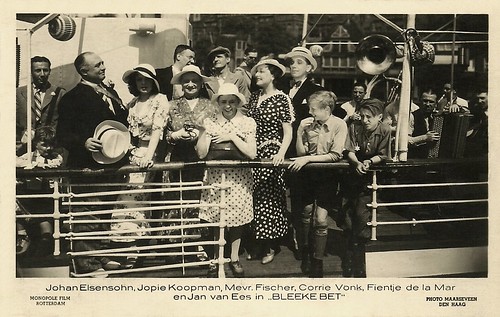
Dutch Postcard by Monopole Film, Rotterdam. Photo: Dick van Maarseveen, Den Haag (The Hague). Publicity still for Bleeke Bet (1934).
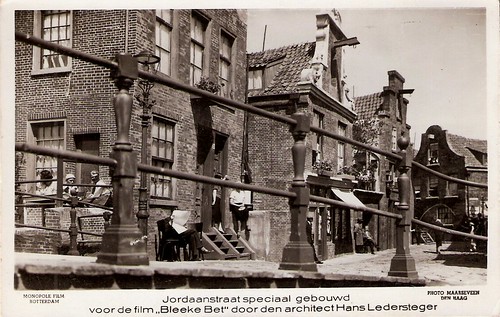
Dutch postcard by Monopole Film, Rotterdam. Photo: Dick van Maarseveen. Still of a set built for Bleeke Bet (Alex Benno, Richard Oswald, 1934), a street in the old neighbourhood De Jordaan in Amsterdam. The set designer was Hans Ledersteger.
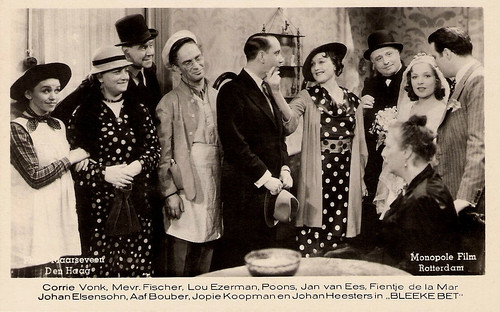
Dutch Postcard by Monopole Film, Rotterdam. Photo: Dick van Maarseveen, Den Haag (The Hague). The still from Bleeke Bet (Alex Benno, Richard Oswald, 1934) shows the happy ending within the centre Jan van Ees and Fien de la Mar as Ka.
Sources: De TheaterEncyclopedie (Dutch), Bekende Dode Nederlanders (Dutch), Film in Nederland (Dutch - now defunct), Wikipedia (Dutch) and IMDb.
This post was last updated on 9 February 2024.

Dutch postcard by Uitgave Weenenk & Snel, Den Haag. Photo: Willem Coret.

Dutch postcard by Hollandia Film Prod. / Loet C. Barnstijn. Photo: publicity still for De Jantjes/The Tars (Jaap Speyer, 1934) with Jan van Ees, Willy Costello and Johan Kaart.

Dutch postcard by M.B. & Z. (M. Bonnist & Zonen, Amsterdam). Photo: Dick van Maarseveen, Den Haag / M.H.D. Film. Jan van Ees and Esther de Boer-van Rijk in Op Hoop van Zegen (Alex Benno, Louis Saalborn, 1934). Collection: Geoffrey Donaldson Institute.
De Jantjes
Johannes Cornelis van Ees was born in Leiden, the Netherlands in 1896. His parents were Christiaan van Ees and Maria van Steenwijk. His siblings were actress Annie van Ees, Chris van Ees en Hendrik Lambertus van Ees.
Jan attended the HBS (Higher Civic School) in Leiden and had an office job in Amsterdam for some time. In 1914, he started his acting career in Rotterdam and he joined the company of Peter Diederick van Eysden, where he was taught by Louis Chrispijn and Alida Tartaud-Klein.
During his career, Jan van Ees worked for different stage companies and also wrote several plays, of which five were published in the stage journal Het Masker (The Mask) (1921-1922).
Together with Eduard Veterman, he published a 1922 monograph on brother-in-law Cor van der Lugt Melsert who had married Jan's sister Annie van Ees. Two years later he published the decadent novel, 'De hoornen van de maan' (The Horns of the Moon), for which Veterman made Aubrey Beardsley-like illustrations.
He made his film debut in the lead role of the silent melodrama Voorbeschikten/Predestined (Tonny Stevens, 1920). He also appeared in the silent production Nul uur nul/Zero Hour Zero (Simon Koster, Curt Oertel, 1928) with his sister Annie van Ees, but his film career went into a higher gear when sound film was introduced in the Netherlands.

Dutch postcard by Vereenigd Rotterdamsch Hofstadtooneel. Photo: Willem Coret, The Hague. Annie van Ees, Jan van Ees, Anton Roemer and Cor van der Lugt Melsert in the stage play 'Boefje' (1922). Caption: "Jan in the brother's house".

Dutch postcard by Hollandia Film Prod. / Loet C. Barnstijn. Photo: publicity still for De Jantjes/The Tars (Jaap Speyer, 1934) with Willy Costello, Jan van Ees and Johan Kaart.

Dutch postcard by Hollandia Film Prod. / Loet C. Barnstijn. Photo: Willy Costello, Suzie Klein, Johan Kaart jr., Marie van Westerhoven and Jan van Ees in De Jantjes (Jaap Speyer, 1934).
The love of his life
Together with Willy Costello and Johan Kaart, Jan van Ees played the three tars in the Jordaan musical De Jantjes/The Tars (Jaap Speyer, 1934). It was only the second Dutch sound film and a huge popular and critical success.
In the next three years, he made four more films. First, he appeared in another popular Jordaan musical, Bleeke Bet/Bleak Beth (Richard Oswald, Alex Benno, 1934), featuring Aaf Bouber.
Then he appeared with Esther de Boer-van Rijk and Frits van Dongen (aka Philip Dorn) in the fisher drama Op hoop van Zegen/Hoping For Blessing (Alex Benno, Louis Saalborn, 1935), based on the often filmed play by Herman Heijermans.
The other two films were the army comedy De Big van het regiment/The Regiment’s Mascot (Max Nosseck, Jan Teunissen, 1936), and the comedy Op een avond in mei/One evening in May (Jaap Speyer, 1936) starring Johan Elsensohn. The latter was a flop and Van Ees' film career halted.
In these films - and also on stage, Jan van Ees often co-starred with Fien de la Mar. Although he was married, she became the love of his life. After he broke up the affair, he made tours through the Dutch West and East Indies between 1936 and 1939.

Dutch postcard by M. B.& Z. (M. Bonnist & Zonen, Amsterdam). Photo: Hollandia Film Prod. / Loet C. Barnstijn. Johan Kaart jr., Willy Costello and Jan van Ees in De Jantjes (Jaap Speyer, 1934).

Dutch postcard by Hollandia Film Prod. / Loet C. Barnstijn. Photo: publicity still for De Jantjes (Jaap Speyer, 1934).

Dutch postcard by Hollandia Film Prod. / Loet C. Barnstijn. Photo: publicity still for De Jantjes (Jaap Speyer, 1934).
Radio detective
Between 1940 and 1945, Jan van Ees was active as a playwright, lyricist, actor, and director. In the war, he worked together with Cor van der Lugt Melsert, first at the Dutch NV Tooneel. In 1942, Van Ees moved with a large part of the Dutch NV Tooneel over to the Municipal Theater Company Amsterdam, Het Netherlands Tooneel of which Cor van der Lugt was the intendant.
In 1945, after the war, he worked as a cabaret artist. Hij wrote texts for Floris Meslier, for whose Theater Plezier (Pleasure Theatre) he performed till 1952. Legendary Dutch cabaret artist Toon Hermans started his career here. Jan van Ees also appeared in the film Morgen komt Mummelman!/Tomorrow Arrives Mummelman! (Alan Penning, 1947).
From 1952 on he mainly worked for the radio and became famous for his portrayal of detective Paul Vlaanderen in a long series of radio plays based on the novels by Francis Durbridge. In 1954 Van Ees published his stage memories under the title 'Wat krijgen we nou?' (What the hell?). He also translated many plays from English to Dutch under the pseudonym Johan Bennik.
On Dutch television, he was seen in the TV dramas Arme Bitos/Poor Bitos (Joris Diels, 1962), based on a play by Jean Anouilh, and De kersentuin/The Cherry Garden (Willy van Hemert, 1963) an adaptation of the play by Anton Chekhov.
Jan van Ees died in 1966 in Hilversum. He was 70. He is interred at the Begraafplaats Westerveld in Driehuis. Jan van Ees was married four times. His wives were Elisabeth Verjans (before 1927), Cornelia Lamberta van Os (1927-1930), Leentje Gast (1940-1946) and finally actress Lucy van Ees. He was the father of radio play actress Annemarie (du Pon-) van Ees.

Dutch Postcard by Monopole Film, Rotterdam. Photo: Dick van Maarseveen, Den Haag (The Hague). Publicity still for Bleeke Bet (1934).

Dutch postcard by Monopole Film, Rotterdam. Photo: Dick van Maarseveen. Still of a set built for Bleeke Bet (Alex Benno, Richard Oswald, 1934), a street in the old neighbourhood De Jordaan in Amsterdam. The set designer was Hans Ledersteger.

Dutch Postcard by Monopole Film, Rotterdam. Photo: Dick van Maarseveen, Den Haag (The Hague). The still from Bleeke Bet (Alex Benno, Richard Oswald, 1934) shows the happy ending within the centre Jan van Ees and Fien de la Mar as Ka.
Sources: De TheaterEncyclopedie (Dutch), Bekende Dode Nederlanders (Dutch), Film in Nederland (Dutch - now defunct), Wikipedia (Dutch) and IMDb.
This post was last updated on 9 February 2024.
No comments:
Post a Comment